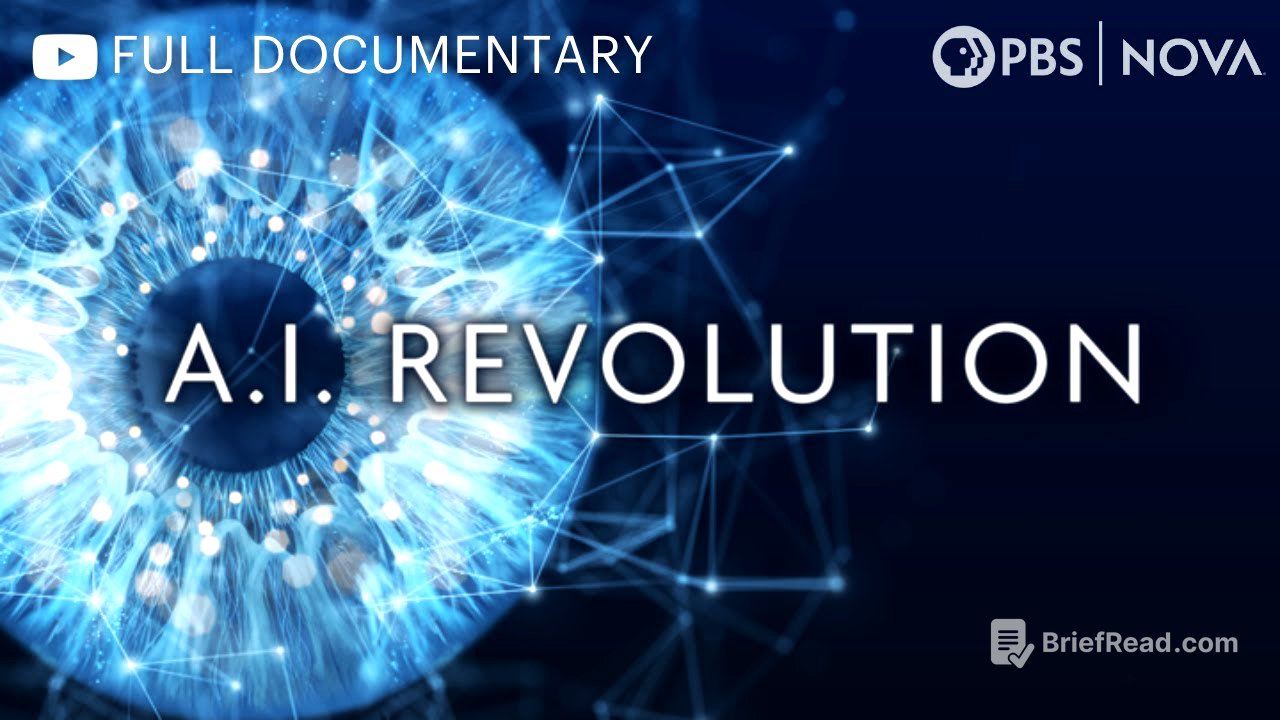TLDR;
This "NOVA" episode, "A.I. Revolution," explores the history, functionality, applications, and potential dangers of artificial intelligence. It traces AI's origins from Alan Turing's theoretical predictions to modern neural networks and large language models. The program highlights AI's positive impacts in medicine, such as improving prosthetics, predicting cancer diagnoses, and accelerating drug discovery. However, it also addresses the risks of AI-generated disinformation and the ethical considerations surrounding its rapid development.
- AI's evolution from theoretical concepts to practical applications.
- The benefits of AI in medicine, including improved diagnostics and treatments.
- The dangers of AI-generated deepfakes and the spread of misinformation.
- The ethical and regulatory challenges posed by rapidly advancing AI technology.
Introduction [0:00]
The video begins by introducing the concept of machines that think like humans, tracing this dream back to antiquity. It questions whether this dream of artificial intelligence has become a reality, highlighting AI's ability to perform tasks previously thought impossible for machines. The video also touches on the potential productivity boosts AI could bring and the concerns about AI-created disinformation. It raises questions about AI's power, functionality, and how to harness its benefits while mitigating risks.
Modern Origins of Artificial Intelligence [5:38]
The modern origins of AI are traced back to World War II and Alan Turing's work on deciphering Nazi codes. Turing predicted that computers might one day match the human brain. The "Turing test" was introduced as a benchmark for AI, questioning whether a machine could converse indistinguishably from a human. In 1956, pioneering scientists coined the term "artificial intelligence" at Dartmouth College. Despite early aspirations, AI capabilities lagged behind for decades. Classic AI reached a milestone in 1997 when IBM's "Deep Blue" defeated Garry Kasparov in chess by analyzing millions of potential moves per second.
How Does Artificial Intelligence Work? [9:05]
The video explains that the human brain learns by processing data and recognizing patterns through over 80 billion neurons. Artificial neural networks are modeled on the human brain, using interconnected nodes or neurons that communicate with each other. These networks learn by adjusting the strength of connections between nodes based on the data they are exposed to, a process called "training." This allows AI to recognize patterns and learn from experiences, similar to humans. Self-supervised learning paradigms are now applied to machines, initially trained on vintage Atari video games.
Improving Prosthetics with AI [16:21]
The video shifts focus to the application of AI in improving prosthetics, particularly for arm amputees. Traditional body-powered prosthetics are contrasted with AI-driven prosthetics that use electric motors. The presenter visits Coapt, a company pioneering AI in artificial limbs, where he tests a system that uses electrodes to read faint electrical signals from his stump. He trains a machine learning algorithm to interpret these signals, allowing him to control a virtual prosthetic on a screen. The system uses a Bayesian classification model to translate EMG patterns into specific movements, learning and adapting over time.
Predicting Cancer Diagnosis with AI [20:20]
The video explores the use of AI in predicting cancer diagnoses, featuring computer scientist Regina Barzilay, who was diagnosed with breast cancer in 2014. Barzilay and radiologist Constance Lehman realized that the human eye is a limitation in the diagnostic system. They developed a convolutional neural network (CNN) to analyze mammograms and predict the likelihood of developing cancer. The software, called Mirai, achieved 75% to 84% accuracy in predicting future cancer diagnoses. They also applied AI to CAT scans of patients' lungs, creating a model called Sibyl, which can forecast lung cancer with 80% to 95% accuracy.
Uses of AI in Medicine [25:13]
The video discusses DeepMind's AlphaFold, pattern recognition software designed to help researchers understand proteins. AlphaFold predicts how proteins fold into three-dimensional shapes, which determines their interactions with other molecules. Knowing a disease's protein shape allows for the creation of drugs to disable it. AlphaFold was trained on thousands of known protein structures and predicted 200 million protein structures. Insilico Medicine uses AlphaFold and its deep-learning models to make predictions about protein structures for drug design, speeding up the drug development pipeline and potentially reducing costs.
Other Positive Uses of Artificial Intelligence [28:48]
AI is being used in various other fields, including financial analysis, fraud detection, and discovering novel materials for clean energy technology. In St. Helena, California, CAL FIRE uses AI to detect early signs of wildfires through a network of surveillance cameras. The AI system, ALERT California, helps dispatchers orchestrate a fast response to nascent fires. Researchers at M.I.T. are also exploring how to make robots good human partners, focusing on safe human-machine interaction. They are developing liquid networks for autonomous vehicles, inspired by the compact neural system of the C. elegans worm, to create AI that can operate on devices with limited computing power.
The Danger of AI Fakes [37:20]
The video addresses the dangers of AI-generated deepfakes and disinformation, highlighting a 2018 video where Jordan Peele imitated Barack Obama using AI software. Hany Farid, a computer science professor at U.C. Berkeley, demonstrates how easily AI can be used to manipulate reality. He used 90 seconds of the presenter's audio to create a synthesized voice that could say anything. The video also discusses a real-world example where an AI-generated image of a fake terrorist bombing at the Pentagon caused a half a trillion dollar drop in the stock market. The video explains how generative adversarial networks (GANs) and diffusion-based models are used to create these fakes.
Conclusion [49:23]
The presenter reflects on his experience using a new myoelectric arm equipped with Coapt A.I., noting the challenges in communicating his intentions to the device. He concludes that while AI isn't yet capable of creating science fiction scenarios like "The Terminator," it's crucial to address the ethical and regulatory challenges posed by its rapid development. Yoshua Bengio emphasizes the importance of honesty and caution in developing AI to avoid potential negative outcomes. The video underscores the need for strategies to ensure safe, secure, and trustworthy artificial intelligence, balancing innovation with risk mitigation.









